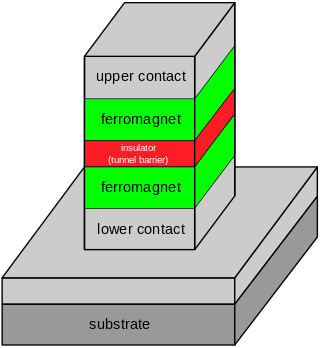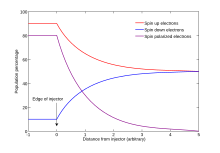Magnetoresistance is the tendency of a material to change the value of its electrical resistance in an externally-applied magnetic field. There are a variety of effects that can be called magnetoresistance. Some occur in bulk non-magnetic metals and semiconductors, such as geometrical magnetoresistance, Shubnikov–de Haas oscillations, or the common positive magnetoresistance in metals. Other effects occur in magnetic metals, such as negative magnetoresistance in ferromagnets or anisotropic magnetoresistance (AMR). Finally, in multicomponent or multilayer systems, giant magnetoresistance (GMR), tunnel magnetoresistance (TMR), colossal magnetoresistance (CMR), and extraordinary magnetoresistance (EMR) can be observed.
Magnetoresistive random-access memory (MRAM) is a type of non-volatile random-access memory which stores data in magnetic domains. Developed in the mid-1980s, proponents have argued that magnetoresistive RAM will eventually surpass competing technologies to become a dominant or even universal memory. Currently, memory technologies in use such as flash RAM and DRAM have practical advantages that have so far kept MRAM in a niche role in the market.

Tunnel magnetoresistance (TMR) is a magnetoresistive effect that occurs in a magnetic tunnel junction (MTJ), which is a component consisting of two ferromagnets separated by a thin insulator. If the insulating layer is thin enough, electrons can tunnel from one ferromagnet into the other. Since this process is forbidden in classical physics, the tunnel magnetoresistance is a strictly quantum mechanical phenomenon, and lies in the study of spintronics.
Colossal magnetoresistance (CMR) is a property of some materials, mostly manganese-based perovskite oxides, that enables them to dramatically change their electrical resistance in the presence of a magnetic field. The magnetoresistance of conventional materials enables changes in resistance of up to 5%, but materials featuring CMR may demonstrate resistance changes by orders of magnitude.

Giant magnetoresistance (GMR) is a quantum mechanical magnetoresistance effect observed in multilayers composed of alternating ferromagnetic and non-magnetic conductive layers. The 2007 Nobel Prize in Physics was awarded to Albert Fert and Peter Grünberg for the discovery of GMR, which also sets the foundation for the study of spintronics.
Magnetic semiconductors are semiconductor materials that exhibit both ferromagnetism and useful semiconductor properties. If implemented in devices, these materials could provide a new type of control of conduction. Whereas traditional electronics are based on control of charge carriers, practical magnetic semiconductors would also allow control of quantum spin state. This would theoretically provide near-total spin polarization, which is an important property for spintronics applications, e.g. spin transistors.

Albert Fert is a French physicist and one of the discoverers of giant magnetoresistance which brought about a breakthrough in gigabyte hard disks. Currently, he is an emeritus professor at Paris-Saclay University in Orsay, scientific director of a joint laboratory between the Centre national de la recherche scientifique and Thales Group, and adjunct professor at Michigan State University. He was awarded the 2007 Nobel Prize in Physics together with Peter Grünberg.
In particle physics, spin polarization is the degree to which the spin, i.e., the intrinsic angular momentum of elementary particles, is aligned with a given direction. This property may pertain to the spin, hence to the magnetic moment, of conduction electrons in ferromagnetic metals, such as iron, giving rise to spin-polarized currents. It may refer to (static) spin waves, preferential correlation of spin orientation with ordered lattices.
Exchange bias or exchange anisotropy occurs in bilayers of magnetic materials where the hard magnetization behavior of an antiferromagnetic thin film causes a shift in the soft magnetization curve of a ferromagnetic film. The exchange bias phenomenon is of tremendous utility in magnetic recording, where it is used to pin the state of the readback heads of hard disk drives at exactly their point of maximum sensitivity; hence the term "bias."
Spin pumping is the dynamical generation of pure spin current by the coherent precession of magnetic moments, which can efficiently inject spin from a magnetic material into an adjacent non-magnetic material. The non-magnetic material usually hosts the spin Hall effect that can convert the injected spin current into a charge voltage easy to detect. A spin pumping experiment typically requires electromagnetic irradiation to induce magnetic resonance, which converts energy and angular momenta from electromagnetic waves to magnetic dynamics and then to electrons, enabling the electronic detection of electromagnetic waves. The device operation of spin pumping can be regarded as the spintronic analog of a battery.
The spin Hall effect (SHE) is a transport phenomenon predicted by Russian physicists Mikhail I. Dyakonov and Vladimir I. Perel in 1971. It consists of the appearance of spin accumulation on the lateral surfaces of an electric current-carrying sample, the signs of the spin directions being opposite on the opposing boundaries. In a cylindrical wire, the current-induced surface spins will wind around the wire. When the current direction is reversed, the directions of spin orientation is also reversed.
Spin-polarized scanning tunneling microscopy (SP-STM) is a type of scanning tunneling microscope (STM) that can provide detailed information of magnetic phenomena on the single-atom scale additional to the atomic topography gained with STM. SP-STM opened a novel approach to static and dynamic magnetic processes as precise investigations of domain walls in ferromagnetic and antiferromagnetic systems, as well as thermal and current-induced switching of nanomagnetic particles.
Gallium manganese arsenide, chemical formula (Ga,Mn)As is a magnetic semiconductor. It is based on the world's second most commonly used semiconductor, gallium arsenide,, and readily compatible with existing semiconductor technologies. Differently from other dilute magnetic semiconductors, such as the majority of those based on II-VI semiconductors, it is not paramagnetic but ferromagnetic, and hence exhibits hysteretic magnetization behavior. This memory effect is of importance for the creation of persistent devices. In (Ga,Mn)As, the manganese atoms provide a magnetic moment, and each also acts as an acceptor, making it a p-type material. The presence of carriers allows the material to be used for spin-polarized currents. In contrast, many other ferromagnetic magnetic semiconductors are strongly insulating and so do not possess free carriers. (Ga,Mn)As is therefore a candidate material for spintronic devices but it is likely to remain only a testbed for basic research as its Curie temperature could only be raised up to approximatelly 200 K.
Discovered only as recently as 2006 by C.D. Stanciu and F. Hansteen and published in Physical Review Letters, this effect is generally called all-optical magnetization reversal. This magnetization reversal technique refers to a method of reversing magnetization in a magnet simply by circularly polarized light and where the magnetization direction is controlled by the light helicity. In particular, the direction of the angular momentum of the photons would set the magnetization direction without the need of an external magnetic field. In fact, this process could be seen as similar to magnetization reversal by spin injection. The only difference is that now, the angular momentum is supplied by the circularly polarized photons instead of the polarized electrons.
Spin engineering describes the control and manipulation of quantum spin systems to develop devices and materials. This includes the use of the spin degrees of freedom as a probe for spin based phenomena. Because of the basic importance of quantum spin for physical and chemical processes, spin engineering is relevant for a wide range of scientific and technological applications. Current examples range from Bose–Einstein condensation to spin-based data storage and reading in state-of-the-art hard disk drives, as well as from powerful analytical tools like nuclear magnetic resonance spectroscopy and electron paramagnetic resonance spectroscopy to the development of magnetic molecules as qubits and magnetic nanoparticles. In addition, spin engineering exploits the functionality of spin to design materials with novel properties as well as to provide a better understanding and advanced applications of conventional material systems. Many chemical reactions are devised to create bulk materials or single molecules with well defined spin properties, such as a single-molecule magnet. The aim of this article is to provide an outline of fields of research and development where the focus is on the properties and applications of quantum spin.
Spin Hall magnetoresistance (SMR) is a transport phenomenon that is found in some electrical conductors that have at least one surface in direct contact with another magnetic material due to changes in the spin current that are present in metals and semiconductors with a large spin Hall angle. It is most easily detected when the magnetic material is an insulator which eliminates other magnetically sensitive transport effects arising from conduction in the magnetic material.

Spinterface is a term coined to indicate an interface between a ferromagnet and an organic semiconductor. This is a widely investigated topic in molecular spintronics, since the role of interfaces plays a huge part in the functioning of a device. In particular, spinterfaces are widely studied in the scientific community because of their hybrid organic/inorganic composition. In fact, the hybridization between the metal and the organic material can be controlled by acting on the molecules, which are more responsive to electrical and optical stimuli than metals. This gives rise to the possibility of efficiently tuning the magnetic properties of the interface at the atomic scale.

Bipolar magnetic semiconductors (BMSs) are a special class of magnetic semiconductors characterized by a unique electronic structure, where valence band maximum (VBM) and conduction band minimum (CBM) are fully spin polarized in the opposite spin direction. BMSs can be described by three energy gaps, the spin-flip gap Δ2 in valence band (VB), band gap Δ1 and spin-flip gap Δ3 in conduction band (CB). Up to now, bipolar magnetic semiconductors, together with half-metal and spin gapless semiconductor, have been viewed as three important classes of spintronic materials.
Bernard Dieny is a research scientist and an entrepreneur. He is Chief Scientist at SPINTEC, a CEA/CNRS/UGA research laboratory that he co-founded in 2002 in Grenoble, France. He is also co-founder of two startup companies: Crocus Technology on MRAM and magnetic sensors in 2006 and EVADERIS on circuits design in 2014.

Jeremy Levy is an American physicist who is a Distinguished Professor of Physics at the University of Pittsburgh.













